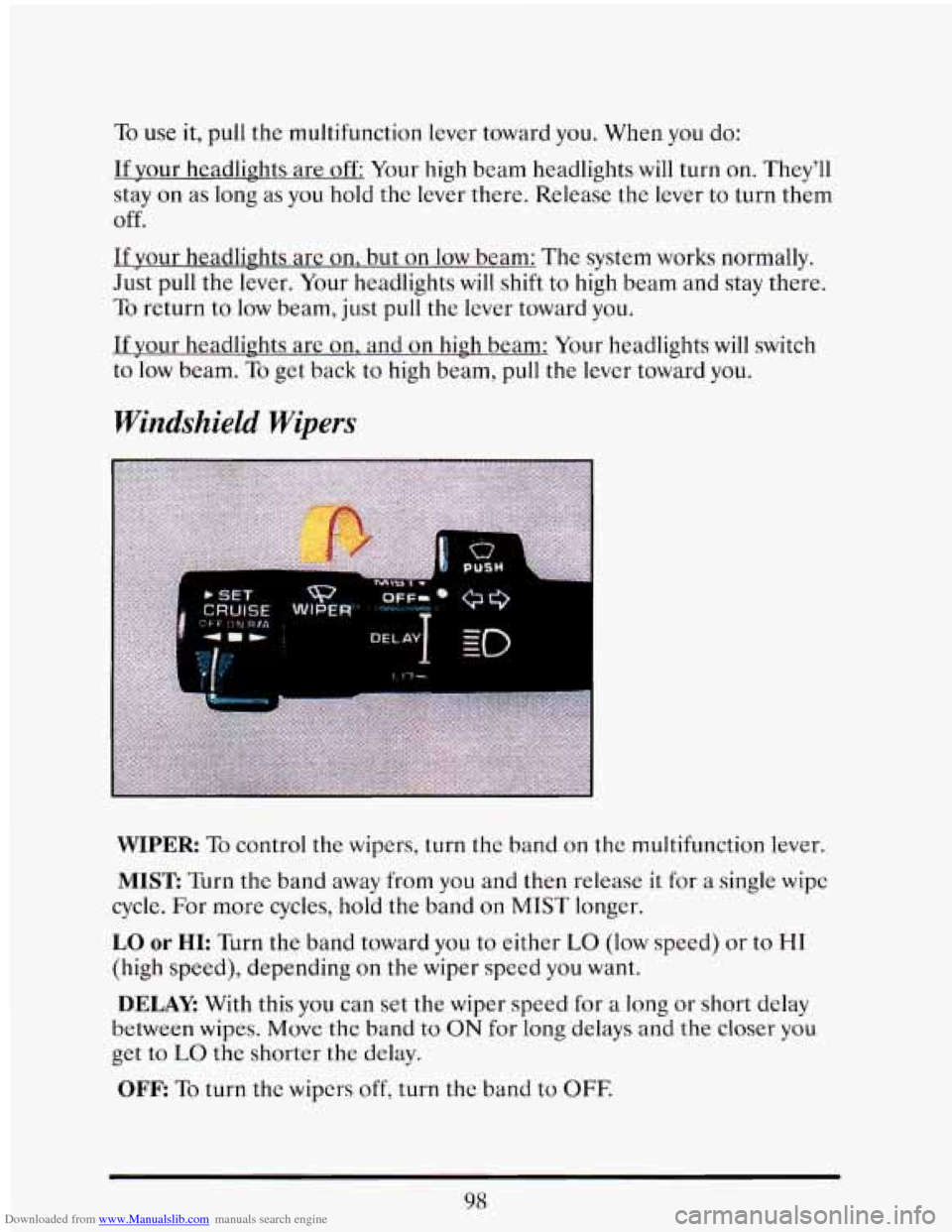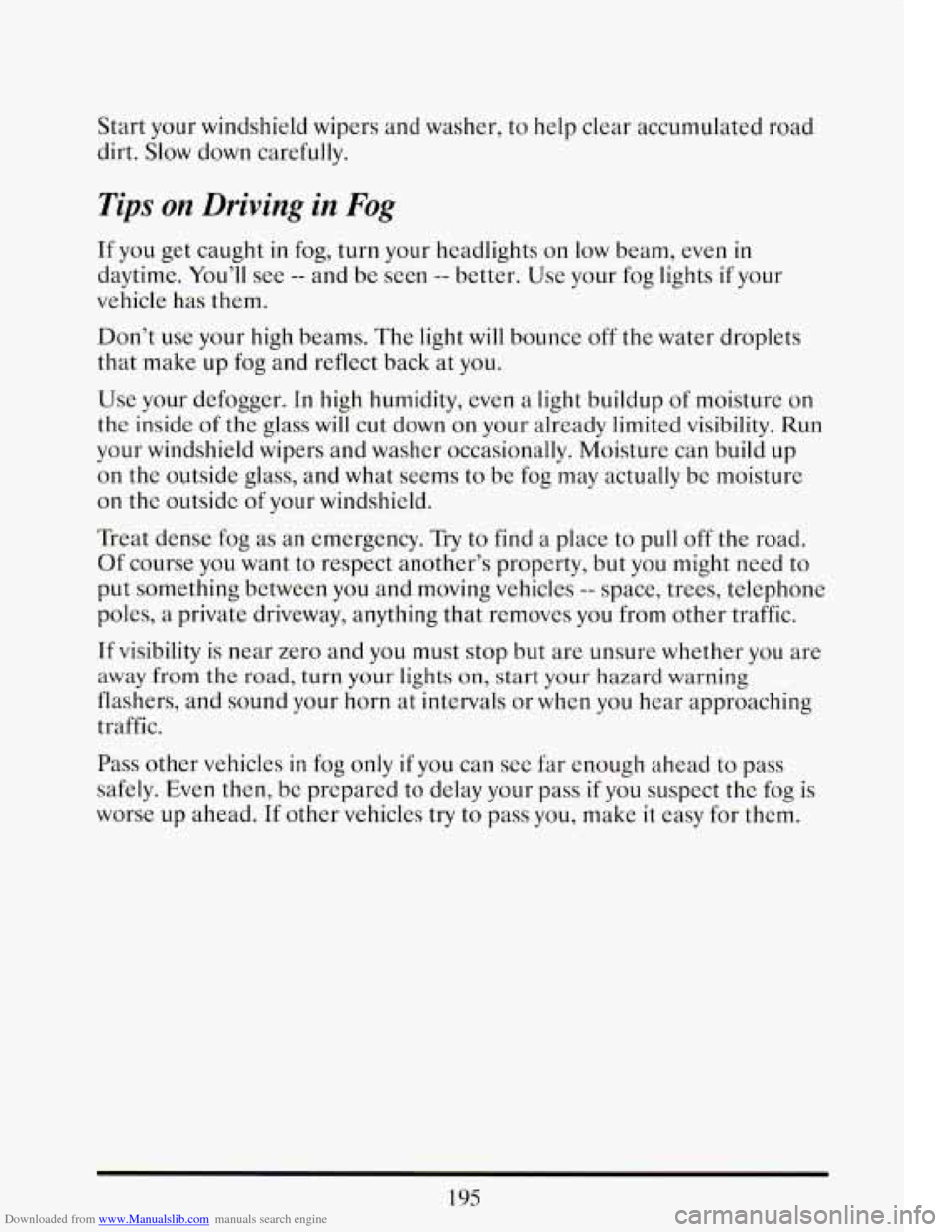Page 18 of 398
Downloaded from www.Manualslib.com manuals search engine These symbols have to do with your lights:
I
MASTER LIGHTING SWITCH
A
HAZARD WARNING FLASHER
n
TURN SIGNALS
LIGHTS OR HIGH BEAM
pt
PARKING LIGHTS I
#O
m FOG LAMPS
These symbols are on some of your controls:
WINDSHIELD
WIPER &WASHER
REAR WINDOW
DEFOGGER
1
WINDSHIELD WASHER
1
VENTILATING FAN
I I
WINDSHIELD DEFROSTER
HEADLAMP
WASHER WIPER
4
Page 109 of 398
Downloaded from www.Manualslib.com manuals search engine THE TURN SIGNALIMULTIFUNCTION
LEPER
The lever on the left side of the steering column includes your:
Turn Signal and Lane Change Indicator
Headlight High-Low Beam
Flash-To-Pass Feature
Headlamp Washers (Export Only)
Windshield Wipers
Windshield Washer
Cruise Control
Page 111 of 398
Downloaded from www.Manualslib.com manuals search engine As you signal a turn or a lane change, if the arrows don’t flash but just
stay on, a signal bulb may be burned out and other drivers won’t see your
turn signal.
If a bulb is burned out, replace it to help avoid an accident. If the green
arrows
don’t go on at ail when you signal a turn, check the fuse (see
“Fuses” in the Index) and for burned-out bulbs.
Headlight High-Low Beam
To change the
headlights from low
beam to high or high to
low, pull the turn signal
lever all the way toward
you. Then release it.
When the high beams
are on, a blue light on
the instrument panel
also will be
on.
Flash-To-Pass Feature
This lets you use your high beam headlights to signal a driver in front of
you that you want to pass. It works even if your headlights are off.
97
Page 112 of 398

Downloaded from www.Manualslib.com manuals search engine To use it, pull the multifunction lever toward you. When you do:
If your headlights are off Your high beam headlights will turn on. They’ll
stay
on as long as you hold the lever there. Release the lever to turn them
off.
If your headlights are on. but on low beam: The system works normally.
Just pull the lever. Your headlights
will shift to high beam and stay there.
To return to low beam, just pull the lever toward you.
If your headlights are on. and on high beam: Your headlights will switch
to low beam.
To get back to high beam, pull the lever toward you.
Windshield Wipers
WIPER To control the wipers, turn the band on the multifunction lever.
MIST: Turn the band away from you and then release it for a single wipe
cycle. For more cycles, hold the band
on MIST longer.
LO or HI: Turn the band toward you to either LO (low speed) or to HI
(high speed), depending on the wiper speed you want.
DELAY: With this you can set the wiper speed for a long or short delay
between wipes. Move the band to ON for long delays and the closer you
get to LO the shorter the delay.
OFF: To turn the wipers off, turn the band to OFF.
98
Page 121 of 398

Downloaded from www.Manualslib.com manuals search engine Twilight Sentinel
The control is next to the headlight switch. It switches your lights on and
off by sensing how dark
it is outside. To operate it, leave the light switch
off and move the control
to any position but off.
If you move the control all the way to MAX, your lights will remain on for
90 seconds after you turn your engine off. If you move the control almost
all the way in the other direction,
so it is just on, the lights will go off
quickly when you turn off your engine. You can change this delay time
from
only a few seconds to 90 seconds.
Operation of Lights
Although your vehicle’s lighting system (headlamps, parking lamps, fog
lamps, side marker lamps and tail lamps) meet all applicable Federal
lighting requirements, certain States and Provinces may apply their own
lighting regulations that may require special attention before
you operate
these lamps. For example, some jurisdictions may require that
you
operate your lower beam lamps with fog lamps at all times, or that
headlamps be turned on whenever
you must use your windshield wipers.
In addition, most jurisdictions prohibit driving solely with parking lamps,
especially at dawn
or dusk. It is recommended that you check with your
own State or Provincial highway authority for applicable lighting
regulations.
107
Page 123 of 398

Downloaded from www.Manualslib.com manuals search engine When the twilight sentinel is on, the headlights will turn off
automatically. Your fog and parking lights will remain on.
If you switch on your high beam headlights, your fog lights will turn off.
They’ll turn back on again when
you switch to low beam headlights.
Rear Fog Lights (Export Only)
To turn them on, push
the lower switch.
A
small indicator light
will glow to tell you
they are on. To turn
them
off, press the
switch again.
Cornering Lights
The cornering lights come on when you signal a turn when the headlights
or parking lights are on. This will provide more light for cornering.
Underhood Light
To operate, turn on your parking lights, then the underhood light will
illuminate when the hood is open.
Daytime Running Lights (Canada Only)
The Canadian Federal Government has decided that “Daytime Running
Lights”
(DRL) are a useful feature, in that DRL can make your vehicle
more visible to pedestrians and other drivers during daylight hours.
DRL
are required on new vehicles sold in Canada.
109
Page 204 of 398

Downloaded from www.Manualslib.com manuals search engine dark. When you are faced with severe glare (as from a driver who doesn’t
lower the high beams, or a vehicle with misaimed headlights), slow down
a little. Avoid staring directly into the approaching lights. If there
is a line
of opposing traffic, make occasional glances over the line
of headlights to
make certain that one
of the vehicles isn’t starting to move into your lane.
Once
you are past the bright lights, give your eyes time to readjust before
resuming speed.
High Beams
If the vehicle approaching you has its high beams on, signal by flicking
yours to high and then back to low beam. This is the usual signal
to lower
the headlight beams. If the other driver still doesn’t lower the beams,
resist the temptation to put your high beams on. This only makes two
half-blinded drivers.
On a freeway, use your high beams only in remote areas where you won’t
impair approaching drivers. In some places, like cities, using high beams
is illegal.
When you
follow another vehicle on a freeway or highway, use low
beams. True, most vehicles now have day-night mirrors that enable the
driver
to reduce glare. But outside mirrors are not of this type and high
beams from behind can bother the driver ahead.
A Few More Night Driving Suggestions
Keep your windshield and all the glass on your vehicle clean -- inside and
out. Glare at night
is made much worse by dirt on the glass. Even the
inside
of the glass can build up a film caused by dust. Tobacco smoke also
makes inside glass surfaces
very filmy and can be a vision hazard if it’s left
there.
Dirty glass makes lights dazzle and flash more than clean glass would,
making the pupils
of your eyes contract repeatedly. You might even want
to keep a cloth and some glass cleaner in your vehicle if you need to clean
your glass frequently.
Remember that your headlights light up far less of a roadway when you
are
in a turn or curve.
Keep your eyes moving; that way, it’s easier to pick out dimly lighted
objects.
190
Page 209 of 398

Downloaded from www.Manualslib.com manuals search engine Start your windshield wipers and washer, to help clear accumulated road
dirt. Slow down carefully.
Tips on Driving in Fog
If you get caught in fog, turn your headlights on low beam: (en In
daytime. You’ll see -- and be seen -- better. Use your fog lignts if your
vehicle has them.
Don’t use your high beams.
The light will bounce off the water droplets
that make up fog and reflect back at
you.
Use your defogger. In high humidity, even a light buildup of moisture on
the inside
of the glass will cut down on your already limited visibility. Run
your windshield wipers and washer occasionally. Moisture can build up
on the outside glass, and what seems to be fog may actually be moisture
on the outside of your windshield.
Treat dense fog as an emergency. Try to find a place to pull off the road,
Of course you want to respect another’s property, but you might need to
put something between you and moving vehicles
-- space, trees, telephone
poles,
a private driveway, anything that removes you from other traffic.
If visibility is near zero and you must stop but are unsure whether you are.
away from the road, turn your lights
on, start your hazard warning
flashers, and sound your horn at intervals or when you hear approaching
traffic.
Pass other vehicles
in fog only if you can see far enough ahead to pass
safely.
Even then, be preparcd to delay your pass if you suspect the fog is
worse up ahead. If other vehicles try to pass you, make it easy for them.
195